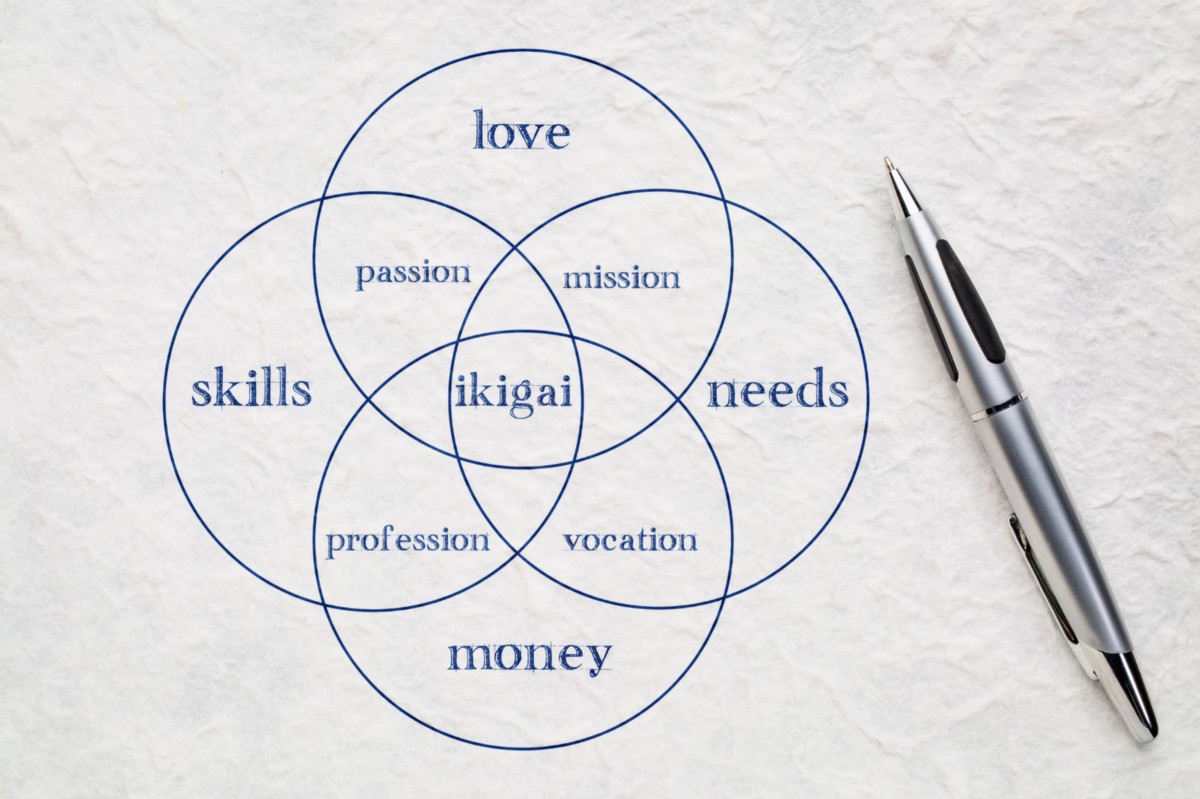Before we dive into Ikigai, let me ask you this: why do you wake up in the morning? What is the reason for you to be? If you’re like me, this question pops into your head now and again, but let’s be honest, not as often as it should.
That’s because we all tend to internalize our happiness and joy in life and condition it on external factors. But is there a way to attain satisfaction and fulfillment from within and in harmony with the outside world? That is what Ikigai teaches us.
What Is the Ikigai Concept?
To make sure we start on the same foot, let me address two quick things: how to pronounce Ikigai and what it translates to. Ikigai is pronounced EE-key-guy.
To hear a person spell the word, follow: how to pronounce Ikigai. When it comes to what Ikigai means, it’s a bit more complicated because there is no direct translation to English, but most scholars who studied it agree on two definitions:
- Your life’s purpose
- Why you get up in the morning
I said it’s tricky because these definitions don’t even begin to describe the full breadth of the Ikigai concept. But with these clarified from the start, let’s delve right in by looking at a diagram of Ikigai first.
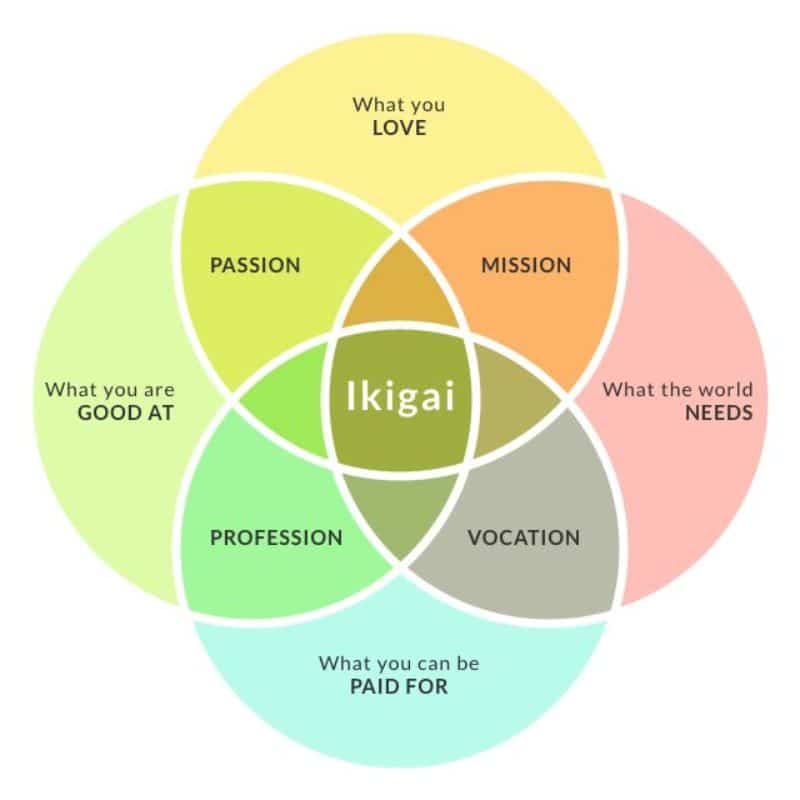
The Elements of Ikigai
You don’t have to overthink to understand the meaning of that point in the center by virtue of the circles that create it. And herein lies the first issue. No matter where you are in your life, you can look at this image and have two reactions:
- I am way too stuck into one of these central circles, or
- I am spread all over, but I clearly lack one of the circles.
So, the Ikigai concept looks at these four pillars in a hypothetical balance:
- What you love
- What the world needs
- What you can get paid for
- What you are good at
But to achieve balance in these critical areas of life, you must seek balance in:
- Mind (mental)
- Body (physical)
- Heart (emotional)
- Soul (spiritual)
If you think about yourself, you probably realize that you are “better,” or at least you put some work behind one or two of these concepts, but, perhaps, not all four. Why is this a problem, though? Can life happiness not be achieved without creating balance?
The answer is yes: balance is not always the goal, but the work to achieve the balance is the secret here. By putting the right kind of work into all four areas of life, your life will enrich even if you never reach the balance. And this is what Ikigai teaches us.
“Only staying active will make you want to live a hundred years.”Japanese Proverb
Where Did Ikigai Originate?
According to the Japanese, the secret to longevity and living your life with purpose lies in not only the purpose itself but in your day-to-day approach to life.
The areas on Earth where people live longest are known as the Blue Zones, a term coined by Dan Buettner in a National Geographic cover story he wrote in 2005. The one Blue Zone area with the largest population with the longest lifespan in the world is Okinawa, Japan.
By living each day with a sense of meaning and inner peace, by eating healthy, connecting, and being one with nature, many people in this area live way beyond 100.
As Hector Garcia, author of the book Ikigai, The Japanese Secret to a Long and Happy Life, states,
“[…] Japanese never really retire (in fact, there’s no word in Japanese to mean retire in the sense it does in English): They remain active and work on what they enjoy because they’ve found a real purpose in life-the happiness of always being busy.”
As you can imagine by now, Ikigai is a way of life, not necessarily some sort of hidden secret available only to a lucky few. It’s a holistic approach to life that considers all the pillars in our lives and addresses them independently and together.
How Did Ikigai Get to Us?
So, what made this concept hit the mainstream media? In 2009, Dan Buettner, a National Geographic writer and explorer, gave a TEDTalk presentation on longevity. Dan has traveled the world and has studied the world’s longest-lived people, trying to understand their secrets and figure out the formula for living a long healthy life.
In this TEDtalk, linked below, Dan talks about the concept of Ikigai. I urge you to listen to this after you’re done with this article, as I firmly believe you will find it insightful and compelling.
In May of 2014, Marc Winn wrote a blog post titled, What is your Ikigai? about the above TED Talk, and gave his views and ideas on the subject. In the middle of the blog post lay the very first representation of the Ikigai diagram:
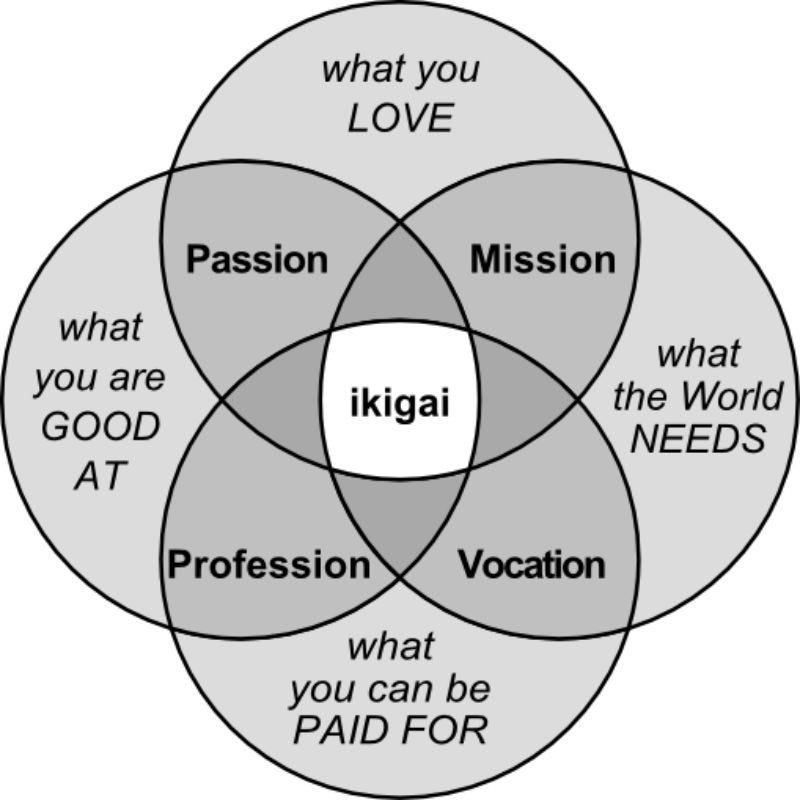
To Marc’s pleasant surprise, the chart became an instant Internet sensation, and users across the globe shared and replicated it thousands of times. Marc wrote a follow-up post in 2017 explaining life after that original article.
The Ikigai Promise
If you read more about the way the Japanese people of Okinawa live, or, for that matter, people in other Blue Zones, such as Ikaria, Greece; Ogilastra, Sardinia; Loma Linda, California; or the Nicoya Peninsula, you will find several common elements.
By living their lives in that way, the people in these areas can center their existence in the middle of the diagram and be tethered by those big life dimensions, namely, doing what they love for a worthy cause with a sense of deep meaning and purpose. Let us look at each of the elements of Ikigai and dig a little deeper into each of them.
1. What You Love
First, let’s focus on the top of the diagram, which talks about what you love. It’s no surprise to anyone that being able to do the things you love is a massive part of living a happy and fulfilled life.
When immersing yourself in an activity or field that you are genuinely and deeply in love with, you will feel a sense of flow, ease, and satisfaction. If the things you love meet the things you are good at, now you have passion.
Remember that despite what you may have heard, passion is not something that you search for. Instead, passion is something that you feel, something you ignite and nourish with rich experiences.
Once you enjoy something and you keep practicing it, you become better at it. The better you become, the more you love it. Soon, that relationship between your skill and love turns into passion.
On the right hand of the diagram, where what you love meets what the world needs, you have your mission, which is one way for us to draw a purpose for our lives.
Our contribution to the bigger world around us gives us a reason for what we do. What happens if you live your life at the intersection of what you love, with what you can do well, and with what the world needs? You will feel delighted and a sense of fullness, but there will be no wealth in your life.
Yes, you are good at it, and you love it, and you feel like your contribution makes a difference, but you earn little to no money.
2. What the World Needs
Now, let’s look at the right side of the chart, which talks about what the world needs. In the context of your personal development, growth, and fulfillment in life, the world doesn’t necessarily have to be the entire world.
After all, that concept itself is difficult to grasp and overwhelming for sure. But you can think of the world as your world. In this context, your world could be your family, community, or business’s clients.
Whatever the world is, it must be outside of you, and you must live and breathe inside it. By focusing on the call from that world, you are now contributing beyond yourself. When you service the world, and you love what you do, you are fulfilling your mission.
Because you sincerely love it and because there’s a need for it, you will feel a sense of fulfillment from living that type of life. Further, when what the world needs meets what you can get paid for, you have your vocation.
Vocation, unlike the mission, is a calling. Basically, the world is shouting, “This is what we need, and we’re willing to pay for it.” Your answer is your vocation, your calling. It is entirely external, unlike the mission that has the personal love relationship intertwined.
So, what happens when you live exclusively in that node between vocation and mission? You will feel excitement generated from the wealth and the fullness of your contribution, but also uncertainty. If you look by elimination, your passion and profession are missing here. That drives uncertainty and a lack of security.
3. What You Can Get Paid For
Next, let’s focus on the third circle — what you can be paid for. This circle is probably easiest to understand because most of us start our post-school life with some jobs. We all know that you need money to afford the material things you need.
Of course, when what you get paid for meets what you are good at, you now have a profession. If you’re good with numbers, get a degree in accounting, and an accounting firm hires you, you become an accountant. That’s clear-cut.
On the other hand, as discussed above, when what you get paid for meets the needs of a group, you have a vocation. So, what do you get when you live your life in that narrow section between profession and vocation?
You have wealth, of course, so that will provide some comfort and security in your life. But, look at what’s missing: passion and mission deriving from what you love. You’ll feel empty because you work on things you don’t love.
There will be no satisfaction or excitement, save for that provided by the wealth you are accumulating, which, as we all know, is short-lived.
4. What You Are Good At
The last circle to look at is your skills or what you are good at. This element, too, is a massive part of our persona as we grow up. From early on, our parents and teachers condition us that we must be good at something to succeed.
We all take different paths and slowly begin to recognize our innate talents. Some of us nurture them; others lose them over time. In the end, we all come out in our adult life good at something.
We learn to understand our strengths and weaknesses and sharpen our skills around them. And here’s the trick about it: being good at something doesn’t mean you must love it. That’s a bizarre relationship between performance and love.
However, when what you do well meets what you love, you have, as we said above, passion. And passion, of course, can be nurtured. When what you are good at meets what you get paid for, you get, once more, your profession.
So, what happens when you live your life exclusively in the sliver between passion and profession? You get a sense of satisfaction, for sure. That’s because passion is present, and being passionate about your job is a great feeling.
But focus on what is missing on the opposite side. By ignoring what the world needs, you will feel useless. You will feel like you are not contributing to anyone and anything.
What Is Your Ikigai?
It’s pretty evident that very few people live their lives exclusively in one of those predefined slivers. We all have a little bit of everything. There are things in life where perhaps we do have a sense of a mission, and there are things in life where maybe we feel satisfaction. The question then becomes, what can we do to tap into all circles across all aspects of our lives?
How to Find Ikigai?
The thing is, you don’t. You don’t find Ikigai; it’s a trick question. You might reach it, but you don’t simply find it, which would imply it has been hidden somewhere from you.
Instead, you create your Ikigai, and then you live by it. Much like love, passion, and fulfillment, Ikigai, which encompasses all of them, cannot live outside of you. Ikigai is the result of you living your life according to its principles.
The temptation for all of us coming out of school is to immediately jump into a field that matches what we have learned and start earning money. The idea is that you must make enough money first, and later you can focus on the things that you love more than just that profession.
That, of course, rarely works. No surprise that most of us find ourselves in our late 40’s edging 50, and realize that we still have about 15 years in our professions, and we feel stuck.
The trick here is to begin your journey on the right side of the chart as early as possible.
First, look at what the world needs, and by the world, once again, I mean your world — The world that you care about. If you haven’t found it yet, you must do so before you begin your journey.
Once you know what your world is and what it needs, begin to sharpen the skills required to address the problems or issues that the world needs solving. From here, you can quickly leap into passion because your increasing experience in a field that solves a real problem for a world you care about profoundly ignites love.
The last step on this journey will be to find a place to get paid for your efforts. So, you see, getting paid is the final leg of the journey. By the time you get there, you have a sense of purpose and a deep why for your actions. Your entire life is now imbued with this sense of meaning, passion, and satisfaction.
Other Ikigai Representations
Once Ikigai became mainstream and more people began to pay attention to it and research it, several variations on its original diagram created by Marc Winn began to appear. Here are some of the most compelling ones I was able to find.
The first one comes from David Maccandless from Information Is Beautiful. I love how David took Marc’s original diagram and extended the circles into ellipses, giving birth to new intersections loaded with meaning.
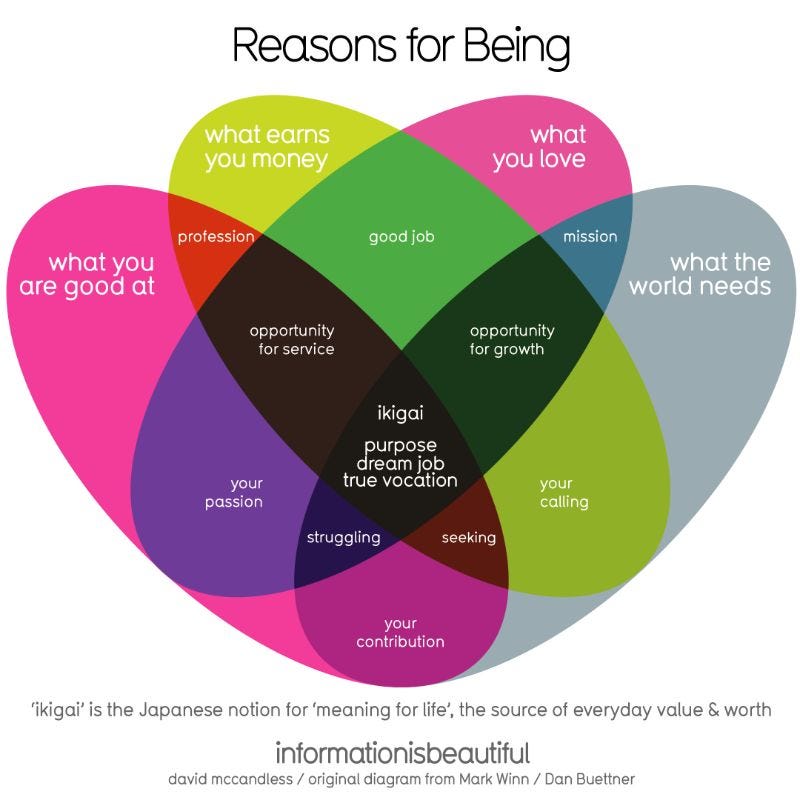
The next representation I like comes from Kyle-Scott in an article discussing why everyone needs a purpose. I like this one because the circles are more extensive, allowing for more pockets that have meaning.
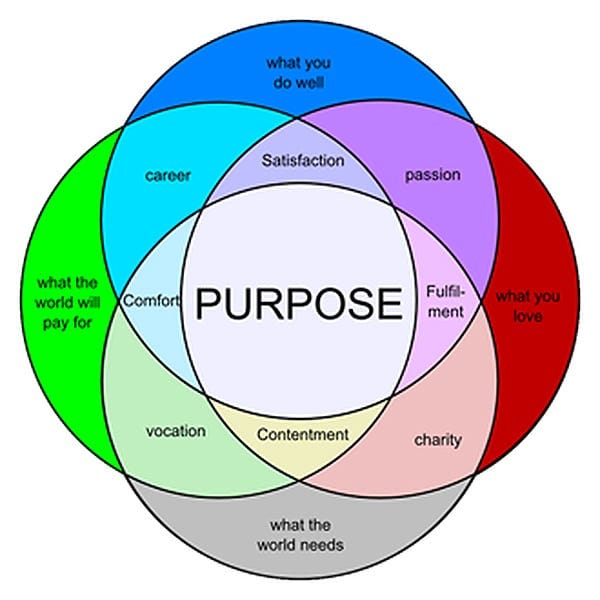
Last but not least, this representation comes from a Japan travel blog. Although it’s the more simplistic of all, the flower petals and the center have a beauty to them.
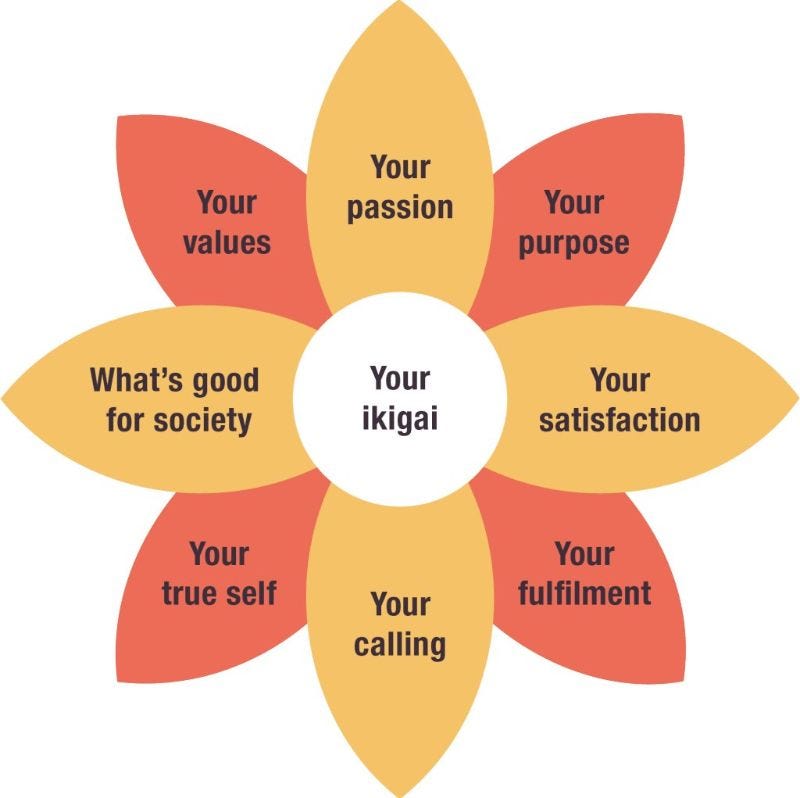
Live a Long and Fulfilled Life
Ikigai is one of those concepts that is both clear and elusive. It’s clear because the diagram that Marc created is so eloquent and direct. On the other hand, it’s elusive because living your life in the way the chart suggests is hard as hell.
By taking small steps in getting more connected with each of the circles, you will slowly and surely begin to approach your own Ikigai. The trick is that once you get to it, you can’t stop. This is not a degree you obtain and put it on your wall to impress people for the rest of your life.
Instead, maintaining Ikigai is a life-long process. It requires you to live your life according to its principles every single day of your life.
This article was originally published on iulianionescu.com under Ikigai: The Ancient Japanese Art of Living a Fulfilled Life.
If you liked this…
…and you want to learn about your values, I’ve put together a simple, actionable cheat sheet that includes a comprehensive list of 250 values: discover your values.


